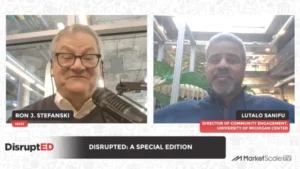What Gives Video Games The Edge Over Video For Distance Learning?
 Ki Karou is the director of product for ST Math content at MIND Research Institute. Ki previously served as a game and learning designer. Before joining MIND, he founded Beyond Math, a tutoring and academic coaching service based in Los Angeles. He can be reached at kkarou@mindresearch.org.
Ki Karou is the director of product for ST Math content at MIND Research Institute. Ki previously served as a game and learning designer. Before joining MIND, he founded Beyond Math, a tutoring and academic coaching service based in Los Angeles. He can be reached at kkarou@mindresearch.org.
Videos are a popular choice for visual learning in home and classrooms all over the world. It’s easy to see why. They convey ideas similarly to a teacher delivering a lecture, and they can offer plenty of visual examples to bring ideas home. Students can pause or rewind a video if they’re having trouble following something. Hopefully, since someone went to the trouble of recording them, they’re a little more polished and of better quality than simply recording a lecture.
Well-designed educational video games, while integrating many of the same learning concepts as videos, offers a fundamentally different approach to learning. The many advantages include active engagement rather than passive watching, informative feedback as the player progresses, and best of all, a safe space to fail and try again, which is central to the learning process.
With time at a premium as students, parents, and educators navigate distance learning, it’s more important than ever that time spent on educational programs is time spent learning, and unfortunately, not all educational games are created equal. Some have become notoriously known as “chocolate-covered broccoli,” with game mechanics sprinkled on top of a boring learning activity. Others are well designed from the ground up and these often take a problem-solving or puzzle-driven approach. Here are a few ideas to keep in mind when evaluating educational games to ensure you’re offering students the best learning experiences games have to offer, rather than veggies with some sugar on top.
Active Learning and Informative Feedback
One big advantage of games over video is that games are a much more active form of learning. They feature two-way communication and allow students to interact with concepts. Whereas videos are a static medium that provide the same experience regardless of the user, video games are responsive to the user’s input and provide a different response based on the unique action of each user.
 One of the elements that make this interactivity such a powerful form of learning is the affordance it provides for immediate and informative feedback. As the user takes an action, they see the consequences of this action and are then able to course correct. To take an example most people are familiar with, think of Mario jumping over a chasm. As the player takes the action, they are able to see how far away they were from making the jump and can use that feedback to inform their next attempt.
One of the elements that make this interactivity such a powerful form of learning is the affordance it provides for immediate and informative feedback. As the user takes an action, they see the consequences of this action and are then able to course correct. To take an example most people are familiar with, think of Mario jumping over a chasm. As the player takes the action, they are able to see how far away they were from making the jump and can use that feedback to inform their next attempt.
When it comes to math puzzles and what we do at MIND Research Institute, that immediate informative feedback comes in the form of visual proof of the math concept. Effective teaching games don’t just tell students that they got it wrong—as if, in the Mario example, instead of seeing where he fell into the chasm, the player simply got a black screen saying “try again.” What students need is a visual explanation as to why their answer was wrong so they can use the information to make another prediction and try again.
This process of making a prediction, taking an action based on that prediction, and then receiving feedback from that action and course correcting is a neuroscientific principle known as the “perception-action cycle.” It is at the core of virtually all learning. When the feedback informs us that our prediction was right, our schema (or mental model) is reinforced. If the feedback informs us our prediction was wrong, we know we need to adjust our model, and feedback helps to inform exactly how.
Think about kicking a soccer ball at a goal. If you miss a shot on goal but see how close you get to the net, you’re going to be able to adjust your action with the hopes of making a better shot the next time. However, imagine a scenario where you take a shot and then don’t get to see whether you made it or not (but someone told you whether you got it in or not). This would be a lot harder to course correct the next time, as you don’t know where you went wrong, and therefore don’t know what to do to adjust.
The Value of Productive Struggle
Just as missing goals is the only path to learning how to make goals, failure is a necessary part of the learning process. For an educational game to be effective, it needs to offer the user puzzles that are difficult enough to require multiple attempts—progressing through the perception-action cycle each time—or they aren’t going to learn anything.
Games are a great vehicle for learners to experience failure for many reasons:
● The stakes are low.
● Everyone knows that games do have a solution if you stick with them.
● They make failing safe.
When kids—or adults, for that matter—don’t feel safe, they don’t learn as well. Research shows that when anyone is in an environment where they don’t feel safe, cortisol is released, putting that individual in a fight or flight mode, rather than a learning mode. Games create a safe space for failure by virtue of being play. Play is fun, it’s something we want to engage in. That’s partly because the consequences are extremely low. For example, if our game mascot JiJi walks across the screen and runs into an obstacle, JiJi doesn’t get mad or judge. JiJi simply turns to the user
and says (with no words): “Hey, there is an obstacle I can’t get past,” and walks back across the screen.
Games in a Larger Instructional Strategy
One of the challenges for the educational gaming industry is that, while games are a perfect fit for problem-based learning, it is not always clear for teachers how to integrate them into the curriculum. And this challenge is exacerbated by the current distance learning environment – educators and parents have to weigh whether educational games are “worth the time” to emphasize. As a result, games end up predominantly being used as a ‘fun’ form of additional practice, rather than being inherently core to the instructional process.
One of the most powerful ways to use games, however, is to provide an opportunity for experiential learning, particularly as an introduction to a new topic or concept. Oftentimes, when educators introduce new ideas to students, they begin with vocabulary or an explanation. Without some experience to pin those new words on, however, they may not make a ton of sense, and oftentimes the explanation is going to feel distant and dry.
If someone’s never seen a cat, for example, and a lesson begins with vocabulary words like “tail” and “purr” and an explanation of how cats bathe themselves, it’s probably enough to give them a hazy idea of the topic. But if the lesson introduces them to a cat, lets them pet it and watch it clean itself, and then introduces vocabulary and explanations, that knowledge is much more anchored in their experience. They can imagine a cat purring and understand how the cat’s rough tongue works to clean its fur.
Games can be a powerful vehicle for problem-based learning or introducing unfamiliar concepts, but not if they’re simply chocolate-covered broccoli. To be effective, they must offer informative feedback in a safe space for failure.








